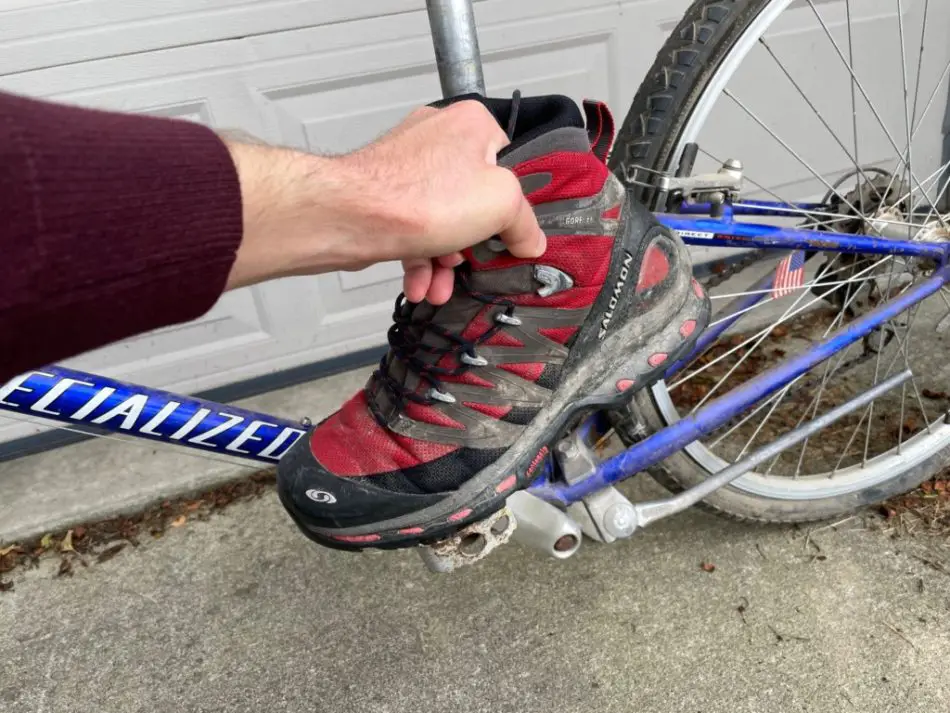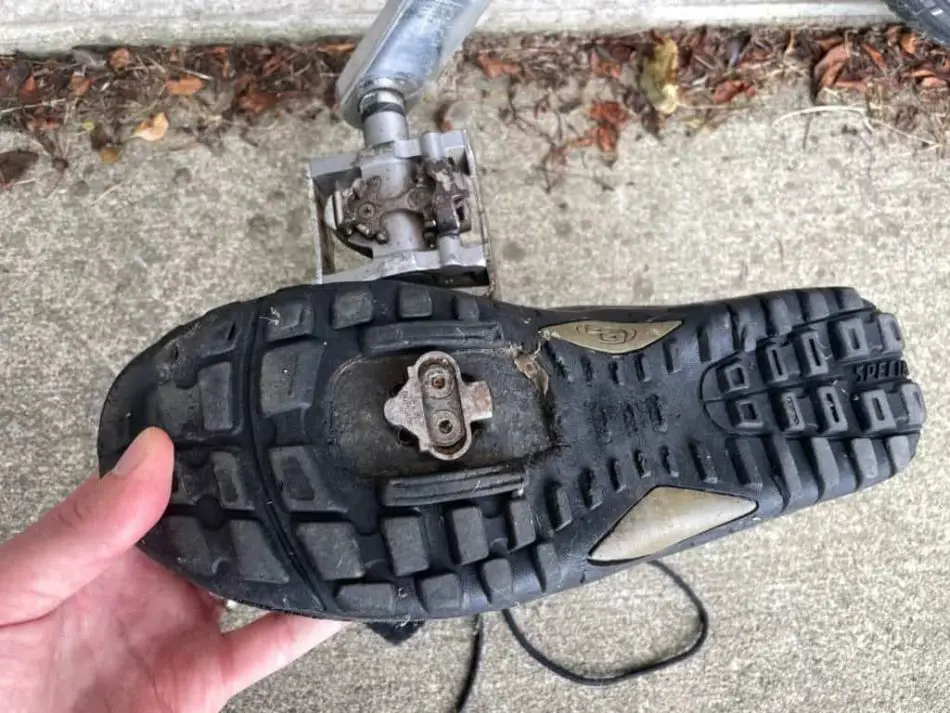Footwear is an essential part of the cycling equation, but it can also be a confusing subject. Hiking boots might seem to be a natural fit for many types of cycling, especially if you’re into mountain biking and trail riding.
But, is it a bad idea to use hiking boots for biking?
Hiking boots and other outdoor shoes work well on bikes with flat pedals, and they’re actually the preferred shoes for some mountain bikers. They’re not a good choice if you have clipless pedals, however, where you should instead get the appropriate clipless shoes.
With that said, there’s still a lot to consider when it comes to cycling shoes, so let’s dig deeper!
Can I Use Hiking Shoes for Mountain Biking?

Hiking boots are a great companion for a mountain biker with flat pedals. They offer additional protection over standard biking shoes and offer more warmth as well. Waterproof versions are even better, since they’re appropriate for more weather conditions.
Personally I don’t like riding rock gardens or singletrack in wooded areas without hiking boots. A couple of stubbed toes convinced me that trail running shoes didn’t offer enough protection, and a good pair of boots protects a good portion of your lower leg.
For areas with a lot of hike-a-bike sections, your choice of footwear may depend on the terrain. Rough terrain is best approached with boots in my opinion, but it’s a hotly debated topic in the hiking community and many find trail running shoes sufficient.
Most shoes good enough for hiking will work fine with a mountain bike, assuming you have the appropriate pedals.
On the other hand, if your bike has clipless pedals, you’ll need to get shoes that fit them. Clipless pedals are hard to ride with normal shoes at the best of times and even worse when you’re mountain biking, where the lack of stability can lead to a serious wreck.
Do I Really Need Mountain Bike Shoes?
Specialized mountain biking shoes aren’t required for mountain biking if your bike has flat (not clipless) pedals. That said, you can still get special shoes for flat pedals, which offer extra grip on a stiffer sole, and generally have a wide flat toe to make pedaling easier.
While not a requirement, getting shoes that are designed for flat-pedal mountain biking can have a lot of benefits, and they’re a welcome addition for most mountain bikers.
If you’re serious about mountain biking as a hobby or sport, I recommend looking for a pair, especially if you do mostly trail riding. And if you want to learn a bit more about the top brands for flat pedal shoes, check out this separate article.
It’s a personal choice, but specially designed shoes are a nice touch. But as a side note, those who do a lot of hike-a-bike trails may not find them quite as advantageous.
And, if your bike has clipless pedals, you pretty much have to get compatible clipless shoes. If you need to walk around when you reach your destination, you can look into a pair of shoes that has recessed cleats, allowing you to walk around without the cleats getting damaged or causing problems. Or, you could pack an extra pair of walking shoes.

What Shoes Go With a Mountain Bike Flat Pedal?
The best shoes for a mountain bike with flat pedals are purposefully designed MTB shoes, followed by shoes appropriate for the terrain you’re in. Most shoes can be used with flat pedals, except for hyper-specialized footwear like bowling shoes or track cleats.
When riding flats, I pick my footwear based entirely on the area I’m in. That usually means hiking boots, but in areas with a lot of steam crossings I’ll use mesh trail running shoes instead.
Essentially, I wear the same shoes I’d wear if I was hiking the area.
For those who’ve had a chain failure 10 miles from the car it’s an obvious choice: there is always a chance you’ll be walking out. It helps if your shoes are up to walking back to wherever you came form.
In general you want the following for any shoes you’re mountain biking with (on flat pedals):
- Grippy soles
- Lightweight
- Flat toe area for stability
That fits a wide range of shoes, the most common exception being dress shoes.
Basically, any sensible footwear for outdoor use will be fine for riding a mountain bike with flat pedals, but some will be better than others.
Are Vans Good for Mountain Biking?
Vans’ skater shoes are a decent choice for mountain biking. They have good grip, a stable sole, and they’re on the cheaper end of things. That said, they’re not appropriate for wet conditions since they’ll lose most of their grip.
If you want a more in-depth view of their use for mountain biking check out our article about using Vans for Mountain Biking!
Can I Use Hiking Shoes for Road Cycling?
With flat pedals, hiking shoes make for solid footwear. The extra protection is less useful riding on roads, so lighter shoes are a better option. Plus, they’re not usable if your road bike has clipless pedals.
The main reason for using hiking shoes when mountain biking is that… well, you often end up hiking. When road biking, walking rough terrain isn’t a concern, so lightweight casual shoes are often enough for shorter rides.
You may want to consider trail running shoes or lowtops instead of boots for road cycling, in most cases you don’t need the extra protection on your toes and top of your foot when riding in town. Plus, you’ll probably be more comfortable with something more lightweight on your feet.
Can You Ride Clipless Pedals with Normal Shoes?
In theory, you can ride clipless pedals with normal shoes, at least with some difficulty. In practice, any serious riding undertaken with clipless pedals requires the appropriate footgear due to the pedal’s smaller size and design.
Sure, if you have no alternative, and you want to take the occasional ride around the block, you can get it done. However, it’s hard! And it’s just not practical to use normal shoes on clipless pedals for any extended ride distance/duration.
You can find easy-to-install conversion kits if you’d prefer flat pedals for short distances and don’t want to replace your clipless pedals entirely. Or, you could even look into a pair of double-sided pedals, that has a clipless pedal on one side and a flat pedal on the other side. I’ve used these myself for years, and I love them!
Are Running Shoes Good for Cycling?
Running shoes are another acceptable, but not optimal, choice for a rider who doesn’t want to invest in cycling shoes yet. They’re lightweight and breathable, but the flexible soles can make them uncomfortable for riding long distances.
Regular running shoes work fine, but they can get uncomfortable after riding for some time. I wouldn’t recommend them for long road runs, but for short commutes and recreational rides they work fine.
Trail running shoes work a bit better, often having a stiffer sole and a little more support around the ankle.
In other words: running shoes are definitely not the best choice for riding, but they’re not bad. You’re still better off with running shoes than casual sneakers or dress shoes for instance.
Does Biking Ruin Shoes?
Biking is easy on shoes for the most part, but it depends on your pedals and riding style. Some flat pedals have very aggressive studs that can damage the bottom of softer shoes, and contact with the ground while moving is a great way to thin out your soles.
Bicycling isn’t completely harmless for shoes, it’ll probably do more damage than a casual stroll, but they won’t tear down shoes rapidly in most cases. To prolong the life of your shoes, avoid any flat pedals with steel studs and try to only put your feet down after being fully stopped.
Novice riders may tear their shoes up more, just due to bad form when riding.
Putting a leg down to stop or catch yourself wears down your soles a significant amount, and if you’re doing it frequently, it will shorten the lifespan of your shoes. Be mindful of it, especially if you have a habit of dropping a foot to stop quickly when you’re riding around town.
